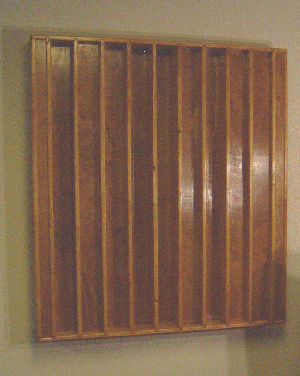
Acoustic diffusers are used to maintain the acoustic energy in a room, but at the same time removing strong echoes. Acoustic diffusion occurs in a haphazard way in many historical buildings through the use of ornate wall decorations and statues. Modern rooms rarely have such decorations but may include curved walls or other architectural features to achieve some of the same effect.
A more studied approach was developed by Schroeder (see refs below) based on number theory. In particular, he based his designs on something called the quadratic residue sequence and its cousins.

A Schroeder diffuser is a reflector contructed using a series of wells with different well depths. Such diffusers are one-dimensional in that if the wells run vertically, the sound is diffused only in the horizontal direction (and vice versa). The differing distances to the reflecting surfaces give the reflected wave a variety of phase shifts designed so the total reflected wave has desired directional properties. Schroeder showed that the quadratic residue sequence could be used to get more or less uniform scattering over a relatively wide range of audio frequencies. That is, a wall which used to be acoustically like a mirror becomes a wall which is acoustically painted white. Hence, much of the energy (the "brightness") remains, however the "house of mirrors" effect from the strong echoes is reduced.
Much research has been done on the Schroeder diffuser. A varient was developed by Feldman (see refs) and is based on a "modified" Primitive Root Sequence. His design has the property that the specular (mirror-like) reflection is minimized, with scattering in other directions more or less uniform. That is, "acoustic glare" is minimized.
The Quadratic Residue Sequence is used to give the depth of the n-th well. The depth is proportional to n2modN, where N is a prime number (larger than 2). Larger N's generally produce more uniform scattering. A table of some resulting sequences is available here. See Schroeder's article for information on choosing well widths and the proportionality constant.
The primitive root sequence (quoting from Feldman) is based on a prime number N (larger than 2) and another integer p which is a primitive root of N. The integer p is a primitive root of N if the sequence pk mod N, k = 1, ..., N-1, generates all the integers between 1 and N-1 exactly once each. The well depths are then given by a constant times pk mod N, k = 0, 1, 2, ... ; the sequence is periodic. A table of some resulting sequences is available here. It is an interesting result that these sequences occur in pairs, with only the order reversed. For example with N = 11, the sequences with p = 2 and 6 are the same sequence but in reverse order; likewise for p = 7 and 8.
Be aware that you can find some references on the web referring to the primitive root sequence above but which actually do not use a value of p which is a primitive root. The result is not a primitive root sequence and its use may not give rise to the desired acoustic behavior.
Feldman's results are based on a "modified primitive root sequence" which adds a well of 0 depth at the beginning of a primitive root sequence (the primitive root sequence never produces 0 by itself).
Two dimensional versions of these diffusers have also been developed.
Some other designs incorporate a distribution of absorbing and reflecting surfaces in a quasi-random pattern. These designs remove some energy while what remains is reflected in a more controlled fashion. Many of these designs are based on binary "maximal length sequences (MLS)." A maximal length sequence can be generated using a simple shift register (or a software equivalent). A similar diffuser design uses a quasirandom distribution of wells of two depths (one of which may be 0), which provide relative phase shifts which differ by 180 degrees -- that is the reflected waves differ by a minus sign.
Some more complicated designs use a series of wells within wells to be effective over a wider frequency range. That idea apparently evolved by considering the scaling associated with fractals.
Refs:
M. R. Schroeder, J. Acoust. Soc. Am. 57, 149 (1975).
M. R. Schroeder, J. Acoust. Soc. Am. 65, 958 (1979).
E. Feldman, J. Acoust. Soc. Am. 98, 623 (1995).
Review: P. D'Antonio and T. Cox, J. Audio Eng. Soc. 46, 955 (1998).
Questions/Comments to: suits@mtu.edu
There are no pop-ups or ads of any kind on these pages. If you are seeing them, they are being added by a third party without the consent of the author.
Back to Physics of Music page